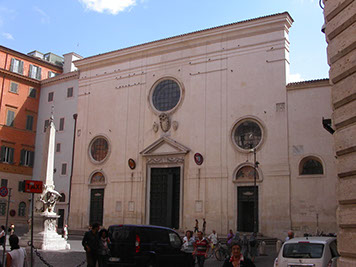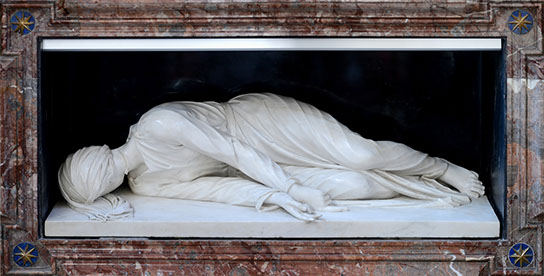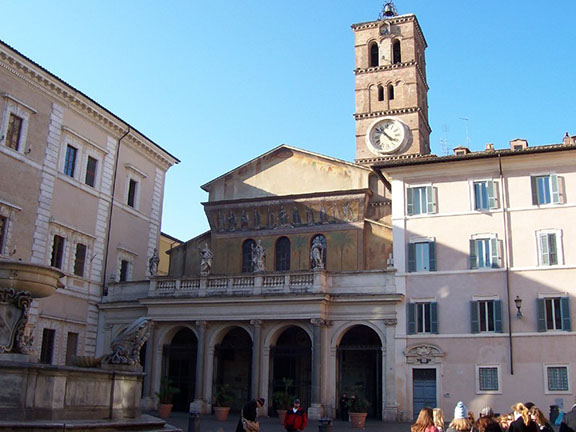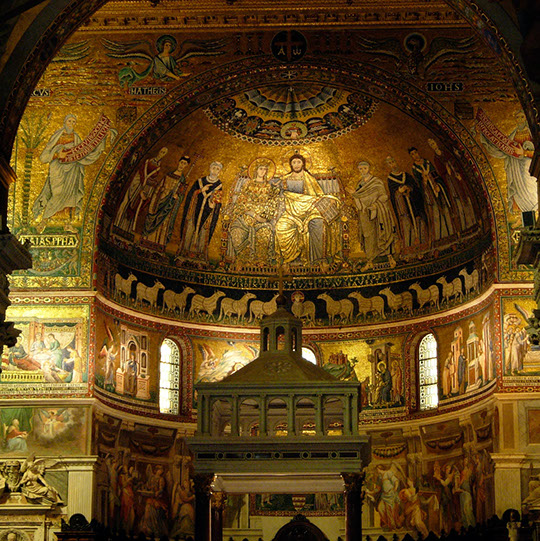There are reportedly over 1000 churches in Rome ... and probably as many guidebooks to tell you all about them, so I have intentionally NOT done so (well, mostly not).
However, here are a few that have something interesting inside and/or outside.
(Still a work-in-progress ... will add more as I get to them)
1. Basilica de Santa Maria sopra Minerva
35 Via del Beato Angelico / 42 Piazza della Minerva - about one block behind the Pantheon.
"Sopra Minerva" ... "over Minerva", the temple built by Emperor Pompey in about 50 BCE and dedicated to the god Isis.
 OUTSIDE
OUTSIDE
A plain Gothic exterior hides a wonderful interior with a blue ceiling with stars.
Bernini's "Elephant with an obelisk on its back" is out the front. (see my Pantheon page)
On the right of the main façade are a series of plaques showing how high various floods of the Tiber reached (particularly in 1870). This is the best set of markers left in the city.
The only remaining mediaeval church with Gothic Rose windows within Rome.
The convent to the left is where, in 1682, the Inquisition led by Torquemada met. Here in 1683, the father of modern astronomy Galileo Galilei, was tried for heresy.
INSIDE
The ceiling is the most beautiful of any church in Rome and actually echoes what some mediaeval churches really looked like.
The fifth chapel on the right was sponsored by the Torquemada family (1468) and features the Annunciation of the Virgin by Antoniazzo Romano (1500) which includes Torquemada the Inquisitor receiving the Virgin's blessing. Torquemada's cenotaph is to the left.
The last chapel on the right has three magnificent frescoes by Filppino Lippi, with the Assumption in the center being the finest Renaissance fresco in Rome (well, the Sistine is in the Vatican City, not Rome).
The Capella Capranica to the right of the altar, the shrine chapel of St. Catherine of Sienna, has two yellow marble balls on the balustrade, a reference to her temperament in confronting wrongdoers in the higher echelons of the Church, including the pope himself.
To the left of the altar is Michaelangelo's Risen Christ (started in 1519, but finished rather poorly by Federico Frizzi in 1521). The loincloth is a later edition which unfortunately cannot be removed as the original member was lopped off to make the cloth fit.
On a column in the left aisle is a marble banner by Bernini, Memorial to Maria Raggi, completed in 1647, that displays the sculptor's complete mastery of creating cloth from marble.
If you visit on a sunny morning, turn to see the light through the rose window above the central entrance door.
2. Chiesa di Sant' Ignazio di Loyola
8/a Via del Caravita / Piazza di Sant'Ignazio
 Dedicated to St Ignatius, though not the seat of the Jesuits ... that is in the Gesu nearby. This church has an amazing ceiling fresco and a false dome by the master of 'trompe' illusion, Andrea Pozzo.
Dedicated to St Ignatius, though not the seat of the Jesuits ... that is in the Gesu nearby. This church has an amazing ceiling fresco and a false dome by the master of 'trompe' illusion, Andrea Pozzo.
OUTSIDE
The church dominates the 1728 symmetrical Baroque/Rococo piazza which is regarded as a masterpiece by Ragazzini. The surrounding buildings form a magnificent Baroque theatre set or a giant chest of drawers.
INSIDE
As an order dedicated to teaching, the Jesuits had severe financial difficulties during the church's 35 years of construction and the planned dome was left off when the church was completed in 1685. So Andrea Pozzo, one of their own priests, had the bright idea of covering the void with an illusionistic oil painting depicting the proposed dome interior. This attracted admiration and remains in place. It is best seen by standing on the marble star in the center aisle, slightly back from the dome.
The giant fresco covering the entire church ceiling is also by Pozzo and is a supreme example of quadratura ... a three-dimensional perspective on a two-dimensional surface. The space is heavily inhabited by heavenly beings.
At the ends are two groups of angels starting fires (a pun on Ignatius's name). The sides have allegories of the four continents then known ... Africa, Asia, America and Europe. The ladies ride on a crocodile, camel, jaguar and horse respectively.
3. Santa Cecilia in Trasteve
Piazza de Santa Cecilia, 22, Trastevere
 Far more legend than fact around St Cecilia, patron saint of music. It is both what is beside and underneath the church that is of the most interest.
Far more legend than fact around St Cecilia, patron saint of music. It is both what is beside and underneath the church that is of the most interest.
OUTSIDE
12th.C. campinale and 18th.C. facade covering a 9th.C. interior. Pretty garden courtyard.
INSIDE
The Cavallini frescoes ...
Not accessible from inside the church but entered from the convent door to the left of the church doors. Knock and you will be let in by a tiny nun. A couple of euro lets you visit the frescoes, upstairs in the choir. Features beautiful multi-coloured winged angels.
In the crypt of the church ... are the remains of a roman house as well as an incredibly ornate chapel decorated in the cosmatesque style.
 St. Ceclia is portrayed under the church altar, supposedly exactly as she looked when exhumed in 1600, uncorrupted and with axe-marks on her neck from her martyrdom.
St. Ceclia is portrayed under the church altar, supposedly exactly as she looked when exhumed in 1600, uncorrupted and with axe-marks on her neck from her martyrdom.
A plaque in front of the altar attests to this.

4. Santa Maria in Trasteve
Piazza de Santa Maria, Trastevere
if Trastevere were a small city on a dusty hilltop in southern Italy, instead of being a district on the 'wrong' side of the river in the heart of Rome, Santa Maria in Trastevere would be its cathedral.

One of the oldest churches of Rome. The floor plan and walls date back to the 340s, and much of the structure to 1140-43.
OUTSIDE
The mosaic features a rare example of the Madonna breast feeding the infant Jesus.
INSIDE
The 22 granite columns with Ionic and Corinthian capitals that separate the nave from the aisles came from the ruins of the Baths of Caracalla, as did the lintel of the entrance door.
It is said that the ceiling is made of Inca gold brought back by Spanish Conquistadors and presented to the church.
The sheep in the dome look particularly smug.
 .
.
Scroll down to see the detail.
(Still a work in progress)
1. Santa Maria sopra Minerva
2. St. Ignatius Loyola
3. St. Cecilia in Trastevere
4. St. Maria in Trastevere
5. St. Maria del Popolo
6. St. Maria del Vittoria
7. St. Maria degli Angeli
8. St. Andrea della Valle
9. Basilica San Clemente
10. Basilica SS Bonifacio
e' Alessio
11. San Georgio in Vilabro
12. San Carino alla
Quattro Fontane
13. San'Andrea al Quirinale
14. Basilica Santa Sabina
... and then there's the
big 4 ...
15. Basilica of Saint Peter
16. Basilica di San
Giovanni in Laterano
17. Basilica Papale di
Santa Maria Maggiore
18. Basilica Papale San
Paolo fuori le Mura


